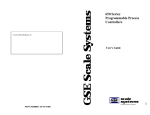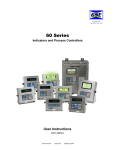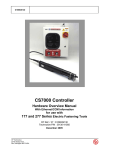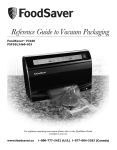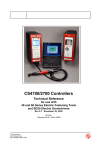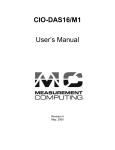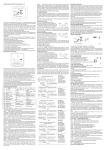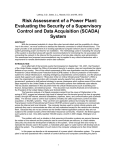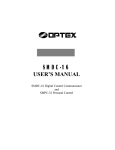Download GSE 550 SERIES PROGRAMMABLE WEIGH INDICATORS
Transcript
GSE 550 SERIES PROGRAMMABLE WEIGH INDICATORS Revision 1.0 April 2001 Part Number 39-10-37661 GSE Scale Systems Information in this manual is subject to change without notice due to correction or enhancement. The information described in the guide is solely the property of GSE, Inc. No part of this manual may be reproduced or transmitted in any form or by any means – electronic or mechanical, including photocopying and recording – nor be sold monetarily without the express written permission of GSE. This prohibition applies to the software, used for computer simulation of GSE hardware and its firmware. Setup files that have not been developed by GSE are neither the property nor the responsibility of GSE. It is highly recommended that all setup files for the 460 Series indicators be backed on disk in ASCII text format. Copyright 2001 GSE, Inc. All rights reserved This user’s guide is intended to be a reference tool for explaining the basic functions. Questions concerning the programming, setup, or servicing of this product should be addressed to your GSE distributor. If you have any questions or need assistance after first reading this guide, please contact a GSE customer service representative at the following number. GSE Scale Systems 22705 Heslip Drive Novi, MI 48375 U.S.A. Phone: (800) 755-7875 www.gse-inc.com GSE Canada, Inc. 617 East Lake Road Airdrie, Alberta Canada T4B 2B8 Phone:(403) 948-9921 Fax: (403) 948-1449 GSE Advanced Industrial Technologies GmbH Hausinger Strasse 4 Langenfeld, Germany 40764 Phone: (49) 21 739 16399-0 Fax: (49) 21 739 16399-9 Phone: (011) 49 2166 94991-0, TELEFAX (011) 49 2166 612 168 Chapter 1 Introduction 1.1 About This Manual This User's Manual contains basic operating information on the Model 550 Weigh Indicator. A Model 550 Technical Reference Manual is also available with all-operating instructions, available options, installation information, and technical information on system setups (i.e. macro Programming). This manual is available through your GSE distributor. The layout of the manual divides basic features of the 550 Weighing Indicator into a chapter to allow for a brief but informative explanation. Information in this manual is subject to change without notice due to correction or enhancement and does not represent a commitment on the part of GSE, Inc. The information described in this manual is solely the property of GSE, Inc. No part of this manual may be reproduced or transmitted in any form or by any means, electronic or mechanical, including photocopying and recording and sold for any monetary figure without the express written permission of GSE. This also includes the software used for computer simulation of GSE hardware and its firmware. Setup files that have not been developed by GSE are neither the property nor the responsibility of GSE. It is highly recommended that all setup files for the model 550 to be backed on disk in ASCII text form. 1.2 Model 550 Features The GSE Model 550 Weighing Indicator is a precision instrument with industrial environment capability. The following list shows the available features of this accurate and durable weigh system component: • • • Highly Visible Display. Brilliant 0.75” high 6 digit vacuum fluorescent display. High Capacity: Capable of powering up to 10 load cells (350 ohm) for demanding applications such as floor, sample scale, tank and hopper scales, etc. Versatile Communications: Programmable RS-232 Versatile swivel stand for table or wall mounting. Time and Date Clock (Battery backed is optional) Front Panel calibration and linearization procedures. Full scale response time from 0.06 to 8 seconds Selectable weighing units: lb., kg., oz, g, custom, etc. DC or AC power operation (10 - 28 VDC or AC), DC connection is internal. Weighing increments: 1, 2, 5, 10, 20, 50, 100, 200 and 500. Six user defined registers for custom communications Can be connected to GSE models 450, 550 and 570 for remote display operation. RS-232 output triggered by time-date clock External relay module with up to 8 setpoints, expandable to 32 outputs (Each block of 8 I/O is Optional). Expandable memory for increased data storage. 1.3 Display • • • • • • • • • • • There are two sections to the display on the Model 550, a large numeric display and a smaller two-line 10 character dot matrix display to the right of the numeric display. Refer to Figure 2, Front Panel Display. The six large numeric digits are used to display numeric data, such as Gross Weight, Net Weight or Tare Weight. The dot matrix display has several purposes. Typically, the first two characters of the upper line will show the weighing units of the displayed data. The last three characters indicate a CENTER ZERO condition when applicable ( -->O<-- ). The lower line of the dot matrix portion of the display will specify the type of data, such as Gross, Net, Tare, etc.. The dot matrix display is also used for specific messages during operation and setup. 1.4 Keyboard The Model 550 keyboard is shown in Figure 3. The Model 550 features a simplified keyboard for operator interface. The function of each key is described below. Some of these keys have additional functions when in the Setup Mode. ZERO Press <ZERO> to zero the current quantity/weight reading. When the meter is at Center Zero the international center-of-zero indication will appear on the upper line of the dot matrix display. This indication is a right and left arrow pointing to a circle. If a Custom Unit’s name is greater than 2 characters, the Center Zero indication is not displayed. If in the quantity mode pressing <ZERO> will set the current mode to a gross zero quantity. If in the weigh mode, pressing <ZERO> sets the current mode to Gross Weight. Refer to figure 3, Model 550 Keyboard. UNITS Pressing the <UNITS> key in the quantity has no effect. Pressing <UNITS> from the weigh mode will toggle the displayed units through the available selections. Converted units are automatically rounded to the appropriate increment. If the "lb/oz" units selection is used, the first digits of the numeric display will read the value for pounds, the last digits will read ounces, and since the upper line of the dot matrix display is used to show the units, there is no center zero indication. As with other units designations, the characters showing units will blank out when motion is present. SELECT Pressing <SELECT> will toggle you through the Net Weight, Tare Weight and Gross Weight, Acc. Net Wt., Acc. Gross Wt. or other enabled operating modes. Refer to the Mode Selection parameters, P300 - P309. Contact your GSE distributor for more information. TARE Pressing <TARE> by itself will perform an auto-tare. A Net Zero is then displayed. You can enter a known Tare Weight into the 550 by keying in the number and pressing <TARE>. In either case, the indicator will be placed in the Net Mode, unless you are in the Tare Mode. Auto-Tare and / or Keyboard Tare may be disabled in the Setup Mode (P166, P167). For more information contact your GSE distributor. PRINT/ Press to send data to a printer, computer or other ENTER device. This key also doubles as an <ENTER> key following certain numeric entries. ID This key has four functions, entering ID's, truck operations, macro menu selection and database access. The exact function of this key depends on the selectable internal setup (P720). UNITS, The <UNITS> and <PRINT> keys double as PRINT, Up and Down arrow keys respectively. While TARE & having accessed any mode or parameter which ID requires a character entry, the <UNITS> key will scroll through a set of ASCII characters. The <PRINT> key will scroll through the set in reverse. The <TARE> key or Right Arrow when pressed will move over to the next character position. The <ID> key or Left Arrow will backup to the previous character.As entries are keyed into the entry buffer, the <PRINT/ENTER> key will complete the entry. When in the weigh or quantity modes, the unit is ready to accept a structured ASCII file for custom setups. The custom setup is received through the units bi-directional communications port on an internal connector of the 550 identified as (J2). 0 thru 9. Press these keys to enter 0 thru 9. Press the decimal point key to establish a decimal point. CLR Press this key to clear a numeric entry mistake prior to entering it into memory. SCALE SELECT The 550 does not have a dedicated scale select button. The following combination of keys just be pressed in order to select one of the four allowed scale inputs. Note that additional scale inputs beyond the standard one scale input are optional. scale #1 scale #2 scale #3 scale #4 1.5 <41> <SELECT> <42> <SELECT> <43> <SELECT> <44> <SELECT> Available Options Not all of the total capability and functionality of the Model 550 is included in the standard version. To take advantage of additional functionality, field installed options are available from GSE. These options consist of hardware and software, and can be installed by your local GSE distributor. It is not necessary to return the instrument to GSE for installation of options. The following listing details all available options for the model 550 weighing system: Compatible Peripheral Options: Barcode Contact Wand Label Printer (Thermal) Document Printer (Dot Matrix) Cable Options: Scanner / Keyboard Cable Thermal (Label or Bar Code) Printer (Eltron) RS-232 Cable Option Memory Expansion Option: Increases internal memory from 512 bytes to 4096 bytes using E2 memory. Time & Date Option: Adds capability of battery backed time of day and date. Database Option: up to 120k memory storage space for target weights, database setups and transactions. (24k also available) Multi-Scale Option: Externally mounted A/D board for sampling and bulk weighing operations. Up to 4 separate scale inputs are available. Process Control Interface Option: Each PCI module has the capability of driving 8 relay inputs or outputs. Up to 4 PCI modules can be daisy linked to one indicator for driving up to 32 relay outputs. Combinations of inputs and outputs may include up to a maximum of 16 inputs with the remaining I/O being used as outputs. Relay Module Option: External enclosure permitting the indicator to drive two relay outputs. Severe Transient Voltage Suppression Option: Protects the indicator from severe radiated voltages on its input lines. Analog Output Option: Provides 4 - 20 mA current loop and variable gain 0 - 10 VDC outputs. Panel Mount Kit option: Provides a means to mount the indicator in an enclosure wall. Splash Guard Option: A clear flexible vinyl cover for use in harsh environments. It will keep the indicator well protected and looking like new. Technical Reference Manual: A comprehensive manual for the advanced operation setups. Includes many examples in each chapter, including macro, database, communications and setpoint setups. Simulation Software Package: This software package is a tool used by programmers to simulate actual application setups without the actual system hardware. This package is used along with the Technical Reference Manual by your local GSE distributor to provide you with custom setups matched to your specific application needs. 1.6 Operating Modes (Brief Explanation) The Model 550 Weighing Indicator, provides four modes of operation available to you: The Weighing mode, Calibration mode, Accumulation mode and the Setup mode. The three operational modes are described elsewhere in this manual. The setup mode provides you access to the seventeen groups of Parameter registers physically resident within the unit. By entering data in the Parameter registers, you can customize your weighing operation to remember the different programming information for your particular weighing application. Contact your local GSE distributor for further information on this feature. Chapter 2 Installation Instructions This section of the user's manual outlines the basic installation of the Model 550. Please take the time to review these important guidelines and step-by-step procedures. 2.1 Positioning the Instrument Table-Top Use The Model 550 Weighing Indicator has been designed with a swivel bracket which lets you tilt the instrument face to any desired angle. When a 550 is placed on a table, the non-slip rubber feet prevent scratching and slipping across the surface when keys are pressed. Environment Suitability The standard Model 550 is supplied in a sealed stainless steel enclosure and may be used in a washdown environment. Care must be taken to insure that the AC power socket outlet is properly protected! The keypad is made of silicon rubber. It may be cleaned periodically with a soft damp non-abrasive cloth. The display window is made from a polycarbonate material which may scratch due to aggressive cleaning. Care must be taken to avoid such dammage. GSE offers a Splash Guard transparent vinyl cover for added protection. Contact your local GSE distributor for more information. Chapter 3 Calibration Mode 3.1 Calibration Mode The Model 550 can be calibrated several ways. The following method described is a quick calibration procedure and assumes that the necessary parameters are selected before the actual calibration is performed. (ie. full scale value, graduation size, etc.) These parameters will normally be set up by your local GSE distributor. 3.2 Quick Calibration The Model 550 can be calibrated as described below. NOTE: A certified weight is required to perform a calibration. Serious inaccuracies could result from using non-certified standards for calibration. 1. From the Weigh Mode press: <10 0> <SELECT> <5 4 3 2 1> <ID> <ENTER> 2. The 550 will prompt you to calibrate the meter by briefly displaying: QUICK CAL! If multiple scales are enabled, the 550 will prompt you with the following, otherwise skip to step 3. Keyin Scl # Keyin the scale number being calibrated and press <ENTER>. NOTE: Pressing the <CLR> key at any point in the calibration routine will back you up one step. 3. The 550 will then display the dead load that is present on the scale and will prompt you to remove any extraneous load by displaying: New Zero? 4. Remove any extraneous weight and press <ENTER>. The 550 will zero the display and prompt you to: KeyIn CalWt 5. At this point you can place the calibration weight on the platform, key in the weight value and then press <ENTER>. If multipoint linearization is enabled, the unit will prompt you with the following, otherwise skip to step 6. Keyin Pnt 2 Add the calibration weight, keyin the value and press <ENTER> for the second calibration point. This prompt above will change for each cal point until 5 points are entered. ie. the next prompt will read Keyin Pnt 3, Proceed to add the cal weight and keyin the value and press <ENTER>. NOTE: If the keyed in weight exceeds Full Scale by +4% or falls below 0.1% of Full Scale, an error message will be displayed. If you forgot to add the calibration weight before pressing <ENTER>, the 550 will prompt you to do so. In this case, place the calibration weight on the scale and press <ENTER>. If an overload exists or the previously set instrument gain is too high, the 550 will display an overload message. In this case, press <CLR> and the 550 will reduce the current instrument gain and return you to step 3 so you can re-start your calibration. 6. The 550 will perform the calibration, display the value of the calibration weight and prompt you: CAL OK? 7. At this point, the accuracy of the calibration can be checked by weight without leaving the Calibration Mode. A. If the calibration was accurate, press <ENTER>. The 550 will prompt you to save the new calibration information. Press <ENTER> to save and then <ENTER> to exit. B. If the calibration is not accurate, press <CLR>. The 550 will return to the "New Zero?" prompt. Proceed as described in step 3 of this section. 8. If the calibration weight was less than 5% of capacity or if calibration, the 550 will prompt you: ReCal Req'd there was a large change in the 9. If so, press <ENTER> and you will be returned to step 2 of this procedure, or press <CLR> to obtain the "CAL OK?" prompt (as described in step 6) and override the re-calibration requirement. You are strongly urged to re-calibrate in order to avoid any serious inaccuracy. NOTE: If the calibration weight was less than 5% of capacity or if there was a large change in the calibration, the 550 will prompt you with the message ReCal Req'd. Press <ENTER>and you will be returned to the beginning of the calibration selections, or press <CLR> to obtain the CAL OK? prompt as described above and override the re-calibration requirement. However, we recommend you perform a re-calibration in order to avoid any serious inaccuracy. Another variation of the calibration process is the linearization procedure. Linearization can be quite useful in improving the absolute accuracy of larger capacity systems which often exhibit poor linearity. This feature if necessary, can be enabled by your GSE distributor. Chapter 4 Truck Weighing Operations 4.1 Introduction One of the applications for which the Indicator is very well suited is the operation of Truck Weighing. This application takes into account the two most frequent situations; dumping or pickup. In Truck dumping, the initial weight of the truck coming in (Truck In) is heavier than when the truck is leaving (Truck Out). In Truck pickup, the initial weight of the truck coming in (Truck In) is lighter than when the truck is leaving (Truck Out). The Truck In / Out capability makes use of the <ID> key to permit entry of truck identification (ID) numbers. The ID's are stored within the Indicator with the incoming weight of the truck. When the truck is on the way out, the In-Weight is compared to the Out-Weight. The Indicator then considers the lower of the two weights to be the Tare Weight, the larger to be the Gross Weight, and the difference to be the Net Weight. Tare Weights may be permanently stored in the Indicator to determine truck weights with a single weighment. One or more of the Custom Transmits may be sent, providing either a ticket documenting the amount of weight picked up or dropped off, or sending the data to a computer or remote display. This feature makes the Indicator an ideal weight indicator for dump site weighing, gravel pit weighing, and many other truck weighing applications. This feature includes the ability to establish and store the tare weight of a vehicle, clear any or all stored weights or transmit the currently stored truck weights. The Truck In/Out feature works in a relatively preset manner. It can be customized to some extent with its setup, and even further with the use of macros (Refer to your GSE distributor). However if complete customization is required then the Database Option should be implemented and the operation can be designed to perfectly fit the intended application. 4.2 Defining Your Truck ID Type Four different types of Truck ID's are selectable with the Truck In/Out feature. The differences between the types are primarily in the size and type of characters, which may be used for the ID. Based on the needs of the application, one of the four types of IDs can be selected. 1. Auto-Sequential ID: The 550 automatically defines a sequential number or ID to each IN weighment. The operator will key in this same number during the OUT weighment operation. 2. Small ID: Allows for manually entering numbers by means of the 550 keypad. The IDs must be less than the value 65535. This method will save memory space 3. Big ID: Allows for manually entering numbers by means of the 550 keypad. This method allows for ID numbers up to a value of 16777215. This method uses slightly more memory space compared to the Small ID selection. 4. ID#6: Allows for manually entering alphanumeric IDs by means of a remote keyboard. Alphanumeric IDs might include the vehicle license plate number. 4.3 Transmission Setups There are four separate events, which may occur with the Truck In/Out feature. These are: Truck In, Truck Out, Tare Stored, and Tare Recalled The data transmissions sent by the 550 during the four "Truck In/Out" events are fully programmable and must be set appropriately in order for the correct results to be printed. Normally these transmissions are used to print tickets for the truck's driver however they may also be for any other purpose, such as printing a log of all truck activity. All transmissions are accomplished through the use of four Custom Transmits, which is part of the indicator's standard setup. There is a setup parameter for each event, which specifies which of the Custom Transmits, are sent when that event occurs. Any combination (from none to all) of the four Custom Transmits may be specified for each event. As each event occurs, the indicator checks its setup to determine which transmissions are to be sent. Not every Truck In/Out application will make use of all four events. First determine which of these four events will be occurring in your application. Next, define on paper the desired appearance of the ticket for these events. If a significant portion of multiple tickets are similar, then these portions may be generated by a single custom transmit. After reviewing your data transmission needs, contact your GSE distributor or the Technical Reference Manual to create the desired custom format of the tickets. 4.4 Methods of Operation Storing the Gross Weight during incoming and comparing the Gross Weight during outgoing are motion delayed events. Thus if motion is occurring at these times, the prompt Mot'n Delay will appear until motion ceases. As with all other motion delayed operations the <CLR> key can be pressed to cancel the pending command. Therefore, the parameters for motion delay before transmitting have no effect on the automatic transmissions sent during Truck In/Out Weighing regardless of their setting. To adjust the determination of motion contact your GSE distributor to adjust the setup of parameters P114 and P115. 4.5 Sequential “Truck ID” Operation Incoming Truck (full or empty): 1. Truck driver drives onto scale. 2. Operator presses <ID>. 3. The Indicator prompts: Keyin ID #. 3. Operator presses <ENTER>. 4. When motion ceases, the Indicator determines the next sequentially available ID and stores the In Weight. Also, any Custom Transmits specified are sent. Normally a ticket would always be printed to record the assigned number. 5. The printed ticket is handed to the driver of the truck. Outgoing Truck (full or empty): 1. Truck driver drives onto scale and hands operator the tag when it came in. which was printed for the truck 2. Operator presses <ID>. 3. The Indicator prompts: Keyin ID #. 4. Operator keys in the sequential truck number from the ticket and then presses <ENTER>. 5. When motion ceases, the Indicator compares the incoming weight to the outgoing weight and copies the higher of the two weights to the Truck Gross Weight register (parameter #12), The lower weight to the Truck Tare Weight register (parameter #13), and the difference to the Truck Net Weight register (parameter #14). The In-Weight and the Truck ID are then deleted from memory. 6. Then the Custom Transmit(s) are sent. 4.6 Small, Big# or ID#6 “Truck ID” Operation Incoming Truck (full or empty): 1. Truck drives onto scale. 2. Operator presses <ID>. 3. The Indicator prompts: Keyin ID #. 4. Operator keys in number of truck and presses <ENTER>. 5. When motion ceases, the Indicator searches memory to see if the entered ID is already stored away. Since this is an In Weight, the ID should not be found and the Indicator prompts WEIGH IN and stores the In Weight along with the ID. The specified transmissions (if any) then take place. 4.7 Storing a keyed In Tare Weight 1. Operator presses <ID>. 2. The Indicator prompts: Keyin ID #. 3. Operator keys in the Tare Weight to be stored, then <TARE>. 4. The Indicator prompts: Save Tare? ...Keyin ID #. 5. Operator keys in number of truck and presses <ENTER>. 6. The Indicator prompts Tare Saved. Then the Indicator stores the entered tare along with the entered truck ID. If the truck ID was previously in memory, then the new Tare Weight over-writes the old data. Then the specified transmission(s) (if any) take place. Storing An Auto Tare Weight: 1. Empty truck is driven onto scale. 2. Operator presses <ID>. 3. The Indicator prompts: Keyin ID #. 4. Operator presses <TARE>. 5. The Indicator prompts: Save Tare? ... Keyin ID #. 6. Operator keys in number of truck and presses <ENTER>. 7. The Indicator prompts Tare Saved. Then the Indicator stores the weight of the truck as Tare Weight along with the entered truck ID. If the truck ID was previously in memory, then the new Tare Weight over-writes the old data. Then the specified transmission(s) (if any) take place. Outgoing Truck (full or empty): 1. Truck drives onto scale. 2. Operator presses <ID>. 3. The Indicator prompts: Keyin ID #. 4. Operator keys in the number of the truck and presses 5. When motion ceases, the Indicator searches memory to see if the entered ID is in fact stored away. Since this is an out-weight, the ID should be found and the indicator prompts WEIGH OUT and recalls the In Weight. The Indicator then compares the incoming weight to the outgoing weight and stores the higher of the two weights as the Truck Gross Weight (parameter 12), the lower as the Truck Tare Weight (parameter 14) and the difference as the Truck Net Weight (parameter 13). When the specified transmissions (if any) take place. The In Weight along with the truck ID is then deleted from memory. <ENTER>. If the recalled weight is a stored Tare Weight, then the message Tare Found is displayed instead of WEIGH OUT. Then the specified transmissions (if any) take place. Also the Tare Weight remains in memory, it is not deleted as with the In Weight. 2 NOTE: Contact your GSE distributor if additional expanded memory (E ) is to be added after truck tare weights have already been stored. 4.8 Printing the Stored IN Weights/Tare Weights 1. Operator presses <ID>. 2. The Indicator prompts: Keyin ID #. 3. Operator presses <PRINT>. 4. The Indicator prompts: Print Data? ... ENTER toPRN. 5. Operator presses <ENTER>. 6. The Indicator transmits the stored In Weights out through the port specified during the setup. The format for the printing is fixed and consists of a heading line followed by lines of truck IDs along with their associated In Weights. Stored Tare Weights are marked Tare Weight. 4.9 CLEARING OPERATIONS A Specific Stored In Weight/Tare Weight: 1. Operator presses <ID>. 2. The Indicator prompts: Keyin ID #. 3. Operator presses <CLR>. 4. The Indicator prompts: Clr ID Row ? ... ENTER ID # . 5. Operator keys in number of truck and presses 6. The Indicator prompts Row Clr'd and then deletes the specified ID and data from memory. Clearing all the Stored In Weights/Tare Weights: 1. Operator presses <ID>. 2. The Indicator prompts: Keyin ID #. 3. Operator presses <CLR>. 4. The Indicator prompts: Clr ID Row ? ... ENTER ID # . 5. Operator presses <CLR> again. <ENTER>. 6. The Indicator prompts: All ID Clr ? ... ENTER toCLR. 7. Operator presses <ENTER>. 8. The Indicator prompts: Sure? ??? ... ENTER toCLR. 9. The Indicator prompts “Prntg Data” and then transmits all the stored In Weights out the port specified during the setup. The format for the print is fixed and consists of a heading line followed by lines of truck IDs along with their associated In Weights. Stored Tare Weights are marked Tare Weight.. All stored weights are then cleared. If the Seq'n storage method has been selected, then the sequential number is reset so that the next stored weight is ID 1. 4.10 Memory Use The number of rows (incoming weights) which can be stored in the Indicator is dependent on how some of the other features are set up within the Indicator and on how much storage memory has been installed. Refer to your GSE distributor for more information on the memory use and how to upgrade with more memory. Chapter 5 Accumulation Operations 5.1 Accumulation Operations The 550 contains two main memory registers into which weighing data may be accumulated. The three registers are the Gross Total, Net Total and the Quantity Total. There are a few specific parameter selections built around the way in which Accumulations operate. These selections are made in the Setup Mode. This chapter will explain how to do an accumulation after the selections are established in the setup mode. Contact your local GSE distributor for more information on accumulation parameters P163 thru P165. 5.2 Performing Accumulations First, enter the desired Accumulation Mode either by pressing the <SELECT> key until one of the Accumulation Modes appears on the display or keyin one of the parameters in table 2 followed by the <SELECT> key. Once in an Accumulation Mode, press the <.> key to add the displayed value to the accumulated total. Accumulate operations are motion delayed. If motion is occurring when an accumulation is requested, the Mot'n Delay prompt is displayed until motion ceases. If motion does not stop, press <CLR> to abort the accumulation. There are six Accumulation Modes with corresponding Mode Numbers as shown in Table 2. The order of appearance of these modes can be assigned when setting up parameters P300 - P309. An accumulation mode can be added to the default selectable modes. The factory default selectable modes are Gross, Net, Tare, Quantity and Average Piece Weight. The Quantity and Average Piece Weight will appear after a sample routine is performed. Contact your local GSE distributor if it is desired to add another mode of operation to the standard default modes. When an Accumulation is made, both the Gross and Net totals are affected. After an accumulation occurs, these values are frozen at their new accumulate total values until the Gross Weight again falls below the value set by parameter P164. Parameter P164 has several selections of percentages of full scale value. The weight must fall below this percentage of full scale before another accumulation is allowed. At that time, these values again resume their active state. This feature prevents double accumulations. A “CLEAR WGHT” prompt appears to warn of such situations. 5.3 Initializing Accumulate Totals The Accumulation Registers may be reset to a new number. This would permit you to enter a total from the previous day or shift to continue the accumulation, or to reset the number to 0. Simply access the accumulation mode by keying in the two digit mode number from table 1 and pressing <SELECT> or if the mode is one of the pre-programmed selectable modes simply toggle to the corresponding mode using the <SELECT> key. Keyin the desired reset value and press <ENTER>. You will then be prompted to confirm the accumulation modification by a display of MOD AC? for 1 second followed by ENTER =MOD. Press <ENTER> to confirm the change or any other key to abort the modification of the accumulation total. The <CLR> key may be used to reset both the net and gross totals to zero. The prompt CLEAR ACS? will appear briefly followed by ENTER =CLR! Press <ENTER> to complete the clearing or press any other key to abort the clear operation. Chapter 6 Printing Operations 6.1 Performing a Print Operation Pressing the <PRINT> key will transmit the information in the custom transmit. The Model 550 has four custom transmits. The custom transmit refers to a table that can be customized to your application. The Model 550 is configured with a factory default transmission shown below. If this is not the desired transmission format, contact your GSE distributor for custom modifications to the transmit format. ID #1: ABC-123 9876.54 lbs Gross Wt. 9864.20 lbs Net Wt. 12.34 lbs Tare Wt. Although all transmissions are usually initiated by pressing the <PRINT> key, exceptions in the setup will allow for remote key printing and continuous printing. The continuous print will transmit the custom programmed information each time the display is updated. This feature is particularly useful with a remote display or an interface with a computer that is monitoring a process. If the receiving device (printer, display or computer) goes off line, is powered down or for any other reason cannot receive the data being sent, the message "Tx On Hold" will appear for a few seconds. Press <CLR> to abort the transmission. If this situation happens while using the continuous print feature, the transmission is suspended, but can be resumed by pressing the <PRINT> key. The 550 is factory defaulted to transmit the custom transmit (previously shown) out the PRINT Port, On Request (PRINT key), Motion Inhibited. These selections are made at parameters P210 thru P212. Connecting a printer cable to the 550 requires entering the enclosure. These connections should be made by a certified GSE technician. Entering the 550 enclosure may void the warranty. Contact your GSE distributor or refer to the technical reference manual if this defaulted configuration does not meet the application requirements. The full programmability of the 550 as defined in its technical reference manual makes it easy to meet virtually all serial RS232-C communications requirements. Additional internal connections other than the serial printer port include a serial bi-directional COM Port, a serial scanner input port, a TTL remote keyboard input and a current loop. CAUTION! Any operation which involves going inside the enclosure should be performed by qualified service personnel only! Hazardous voltage is accessible within the enclosure. Chapter 7 ID Operations The Model 550 has six ID parameters which may be used to store such things as part numbers and descriptions, bin locations or any other alphanumeric item that will be used during operation. The 550 is factory defaulted with the first ID pre-programmed with the name “ID #1”. The default ID size for ID #1 is factory defaulted to 12 characters. The maximum ID size can be set to 49 characters. The first ID (ID #1) is also one of the parameters in the factory defaulted custom transmit. Entering information into ID#1 is explained in the following sections. 7.1 To View an ID To access the first ID parameter while in the Weigh Mode, press <ID>. The numeric display will read "id X" where "X" is the number of the first enabled ID. The upper line of the dot matrix display will show the first five characters of the ID name and the lower line will show the first five characters of the ID value. To access any other enabled ID, either press <X> <SELECT> where "X" is the number of the ID, or press <SELECT> repeatedly. If you try to select an ID that is not available, the 550 will display "Entry Error". Press <SELECT> at the last enabled ID to exit the ID Mode. You may press <ID> at any time to exit the ID Mode. 7.2 To Enter an ID Value If the ID value will be entirely numeric simply access the ID, press the numbers on the numeric keypad and press <ENTER>. The entry you make here will overwrite any previously entered information. Once an entry is started, an arrow symbol will appear in the upper line of the dot matrix display. The entered digits will then appear on the second line and will scroll across the lower then the upper line. You may enter up to the maximum number of digits programmed in the Setup Mode (12 characters is the factory default and 49 characters is the maximum selectable). Once an entry has been started, the <ID> key acts as BACKSPACE keys. If <ID> is pressed with only one character on the display, the entry mode would be canceled and the previous display would appear. <CLR> may be pressed at any point during entry, prior to pressing the <ENTER> key, to clear the entered characters. Pressing <CLR> after first accessing the ID will clear the existing ID contents and move you to the next available ID. To replace the existing contents, simply enter new information as described previously. If <TARE> is pressed after the ID is accessed, the current ID data is copied into the entry buffer and the last character of the existing ID entry would be shown in the last (bottom right) position on the display. This lets you add characters to the end of an existing entry or modify the last characters by using the backspace function. Alphabetic and other characters may be entered at any point by pressing the <UNITS> key while in the ID entry mode. An "A" will appear in the display. At this point the <UNITS> and <PRINT> keys are used to scroll up and down through the entire standard ASCII character set. The <ID> key can be used to backspace, shifting all the previously entered data down toward the lower right corner, with the last character being lost. Pressing <TARE> would shift the entire previous entry toward the left thus making room for a new character. This new character would be an "A". If the entry length exceeds the setup size, the error message "Entry >> Max!" is displayed briefly. The extra characters which surpass the setup size are automatically eliminated and the remaining entry is then displayed. Press <ENTER> to store the remaining entry. 7.3 To Store an ID Entry After completing your entry, press <ENTER> to store it as the new ID value and move to the next enabled ID. If the ID was the last enabled ID, then the 550 will resume the mode, which was active when the ID mode was entered. To advance to the next ID without changing the data for the current ID, press <ENTER> without making an entry. Chapter 8 Time and Date 8.1 Introduction The standard Model 550 weighing indicator includes a Time-Date feature which is non-battery backed. This means that when the feature is used, the time and date must be entered every time the instrument is powered up. The 550 can be set up to prompt you to enter the time and date at power up. If entering the time and date at each power up is considered undesirable, a battery-backed Time-Date option is available at additional cost. The Time-Date feature permits printouts with time and day of the week and the date in many possible formats. Consult with your local GSE distributor for installing battery-backed time-date. NOTE: In the following discussion, HH is a 2 digit representation for hours, MM is minutes, SS is seconds, MO is month, DA is day and YR is year. When the 550 is powered up, the time and date clock is set to Jan 1, 1970, 00:00:00 am (the UNIX computer standard). If the clock is not reset at powerup, either by the operator or by having the time-date option installed, the current time and date will be the elapsed time since power-up. A new Time and Date value can be keyed in by accessing the time-date setup parameters starting at Parameters P500 through P515 (refer to Model 550 Technical Reference Manual or contact your local GSE distributor). The 550 can be also be set up so that the time and date are displayed upon powerup. Time and date are displayed in the large numeric display in the format "HH.MM.SS" and "MO.DA.YR" (or DA.MO.YR if set for the international style). If not battery-backed, the upper line of the character display reads "enter". The lower line of the character display reads "Time" or "Date" as appropriate. If the battery-backed time-date option is installed, time and date are each displayed for about 3 seconds and no changes are allowed. If desired, you can press <ENTER> to end the Time-Date display before the 3 seconds is over. 8.2 Viewing Time and Date While in the Weigh Mode, the time and date can be displayed simultaneously in the dot matrix and main displays. Press 11 <SELECT>. (This can also be accomplished by adding parameter 11 in as one of the selectable modes in the P300 parameters). Contact your local GSE Distributor for more information. The date is then displayed on the large numeric display in the format "MO.DA.YR" (or DA.MO.YR for international style) and the time is displayed on the dot matrix display in the format "HH:MM:SS". The time may be displayed in a 24 or 12 hour format with an "am" or "pm" displayed as appropriate, depending on the setup of time-date. 8.3 Entering New Time A new time may be entered at power-up. Make sure parameter P502 is set for “yes”. This will select the operation to prompt the operator to enter a new time each instant the unit is powered up. The new time is entered by keying in "HH.MM.SS" in a 24 hour format! Hours and minutes entries must be separated by a decimal point. Seconds entry is optional, and if omitted, they are set to zero. To specify seconds, it also must be separated from minutes by a decimal point. Leading zeroes need not be entered. For example, if you enter "8.9.45" and press <ENTER>, the time will be set to 08:09:45; if you enter "15.02" and press <ENTER> the time is set to 15:02:00. If time is entered improperly, the prompt "try h.m.s" is displayed. 8.4 Entering New Date A new date may be entered at power-up. Make sure parameter P502 is set for “yes”. This will select the operation to prompt the operator to enter a new date each instant the unit is powered up. The new date is entered by keying in "MO.DA.YR" (or "DA.MO.YR" if international format was selected) followed by the <ENTER> key. Month, day and year entries must be separated by decimal points. Leading zeroes need not be entered. For example, if you enter "4.1.91" and press <ENTER> the date is set to 04/01/91. If the date is entered improperly, the prompt "try m.d.y" (or "try d.m.y" for international format) is displayed. 8.5 Adding Time and Date to the Custom Transmit If the time/date must be added to the custom transmit, add parameter 11 to the custom transmit table. The first custom transmit is located at parameter P1000. This table also includes the factory defaulted custom transmit shown in chapter 6, Print Operations. The 550 has 3 other custom transmit tables for a total of 4 custom printouts of 1000 characters apiece. Chapter 9 Troubleshooting This section of the User’s Manual provides information on error messages, trouble-shooting and servicing the Model 550 weighing indicator. Some information included in this section refers to parameters that are not discussed in this manual. They are provided as a "quick look-up" for factory trained service technicians. 9.1 Error Messages (overview) The following is a summary of all of the error messages within the 550. They are listed below in numerical order. The leading two digits will appear on the numerical portion of the display, and the message will appear on the two lines of dot matrix display. Following each message is a summation of possible causes and probable remedy. 9.2 Operational Mode Error Messages 02 UnderLoad! Input signal less than negative full scale. If this is due to excessive loading, reduce the load. Otherwise check the load cell connections. If a 4 wire load cell cable is being used, check that the sense jumpers are in place. Verify that the capacity selection P110 is correct. Use the information parameters, especially P61100 to check the setup and input signal. 03 Over-Load! Input signal is greater than positive 04 # > Dsply Number to be displayed will not fit within 6 digits. This will not normally occur for the Gross, Net or Tare Weights but may result while displaying the accumulated totals if the amount exceeds 999,999. Either clear the totals or settle for only being able to transmit the totals. full scale. Use same check as for underload. 05 Zero> Max.! An attempt was made to zero out more than allowed per P118 selection. Use the <TARE> key for subtracting off container weights or if large dead-load is always to be present, apply this dead-load during the No Load? prompt during calibration to permanently eliminate the offset. 06 Tare>F.S.! Tare entry was greater than full scale. Most likely the entered tare value was incorrect. 07 Tare < 0 ! Negative tare attempted, but not allowed per P162. For auto-tares, the GROSS Weight must be greater than zero unless P162 is changed to allow negative tares. 9.3 Setup Mode Error Messages 10 Entry>Max! An entry was made which had more characters than allowed. 11 WRONGCODE! The incorrect access code was entered, thus preventing changes. In order to access the Setup Mode, either the proper code must be entered or the <ENTER> key must be pressed alone (to view selections without making changes). 12 No Mods! The Setup Mode is being accessed, but changes are prevented. 13 OutOfRange An entry made for a selection was beyond the range of valid choices. 14 Must Keyin The choice for the current parameter must be keyed in. 15 Size>998 ! The size of one of the Custom Transmit setup has exceeded the limit. 16 CHECK JUMPR A programming operation was attempted when the program jumper is installed. Installation of this jumper will prohibit any programming changes. 9.4 Hardware Problem Error Messages 21 EEROMerror Error reading data from the EEPROM. Possible U9 and U11 problem. 22 EEROMerror Error writing data to the EEPROM. Possible U9 and U11 problem. 23 CheckU6 Supplementary error message for above errors. 24 EEROMFull! The setup being attempted requires more EEPROM than is currently installed. 25 DefltSetup Upon power-up the Indicator has not found the proper codes. Therefore all parameters have been reset to factory default values. 26 Bad Setup The stored data has a checksum error. Check all parameters or re-load setup. 27 RE-BOOT! The indicator cannot use the EEPROM for data storage, so it is attempting to power-up again to cure the problem. 28 NoRAMAVAIL The current setup requires more RAM than is currently installed. Either contact your dealer or the factory. 9.5 Calibration Error Messages 30 F.S.>MAX! The entered calibration weight, together with the currently applied signal, indicates that the full-scale signal will be greater than the allowed maximum of the Indicator. Verify that correct entries have been made for the capacity, P110, and for the calibration weight. If all appears correct, refer to the use of the information parameter P61103, and determine the output (in mv / volt) of the connected load cell. 31 F.S.<.1mVv The entered calibration weight, together with the currently applied signal, indicates that the full scale signal will be less than the allowed minimum of the Indicator. Verify the proper entries for the capacity, P110, and for the calibration weight. If all appears correct, refer to the use of the information parameters, P61103 and P61104 and determine the output (in mv / volt) of the connected load cell. 32 ADD MORE! The applied weight during calibration was less than 0.1% of capacity. More weight than this is required. Refer to P61104 if this is incorrect. 33 ReCALReq'd The just completed calibration is insufficient to guarantee accurate results due to either the cal weight being less than 5% of capacity or this was the first calibration of this platform to this Indicator and therefore the coarse gain was adjusted by the Indicator. 34 RES> 25K! The current combination of capacity P110 and increment P111 result in a resolution greater than 25,000 graduations. This is simply a warning in case this was not intended. 35 RES>100K! The current combination of capacity P110 and increment P111 result in a resolution greater than 100,000 graduations. This is not allowed and as soon as any key is pressed the instrument will jump back into the setup mode to parameter P110 to verify the settings. 36 RES< 100! The current combination of capacity P110 and increment P111 result in a resolution less than 100 graduations. This is simply a warning in case this was not intended. 37 RES< 1 !! The current combination of capacity P110 and increment P111 result in a resolution less than 1 graduation (i.e. the increment is greater than capacity). This is not allowed and as soon as any key is pressed the instrument will jump back into the Setup Mode to parameter P110 to verify the settings. 9.6 General Error Messages 99 Can't Set! An attempt to enter a value for a parameter which is not field changeable, such as the serial numbers or the audit trail counter results in this message. - - Cksumerror Upon each power-up, the Indicator tests the integrity of its EPROM. If the result is not correct this message is displayed and the Indicator is not usable. Verify that the EPROM (U12) is installed properly (no bent over pins). 9.7 Miscellaneous Messages - - EntryError This error message is the most commonly used. The primary causes are entering a value preceding a key (such as <ZERO>) which is not allowed, entering alpha data for a numeric selection, or entering a fractional value for an entry which only accepts whole numbers. This may occur while in the Setup Mode or one of the operational modes. 9.8 Communications Error Messages par'y error This indicates that the parity of a received character did not match the parity specified in the Setup Mode, parameter P202. This could also result if the baud rate (P200) or the number of data bits (P201) are incorrect. ovrun error This indicates an over-run error where an additional character was received while the receive buffer of the 550 was full, and thus the extra received character will be lost. frm'g error This indicates that the stop bit of a received character did not occur when it was incorrect parity setting port error This indicates that the 550 did not check its receive data register in time, thus missing a character. If this error should occur, please notify your GSE distributor or the factory. To prevent the problem, try reducing the baud rate (P200). tx on hold This will occur if a data transmission is held up for two seconds of more due to a de-asserted handshake. Refer to the description of parameter P209 for more information. tx abort This occurs if the <CLR> key is pressed when the tx on hold error message is shown or if P209 is set for abort and the transmit buffer becomes full. tx con'd This will appear briefly when the handshake is re-asserted after the tx on hold message occurs. 9.9 Service There are no user-serviceable items in the GSE Model 550 Scale Indicator! Service must be performed by qualified service technicians only! Attempts to service this instrument by unqualified personnel may void the warranty! CAUTION! Any operation which involves going inside the enclosure should be performed by qualified service personnel only! Hazardous voltage is accessible within the enclosure. 9.10 Trouble-Shooting DATA TRANSMISSION: If a data transmission of any weight-related numeric data such as Gross, Net or Tare, is sent as dashes, an overload or underload (negative overload) condition was in effect. Remove the cause of the overload (or underload) and repeat the transmission. Check also the setup of parameters P204 and P209. DISPLAYED WEIGHT: If an overload or underload occurs due to an electrical overstress (EOS) normally due to lightning or ESD discharge, then press the <CLR> key. The message "wait 1" will appear for about 1 second. The A/D converter (U22) will then be reset and the system should again be functional. If not, power down for a few seconds. If the Indicator still does not work properly after power-up, check the load cell or platform wiring. If okay, permanent damage may have occurred, most likely to the instrument amplifier (U23).



























